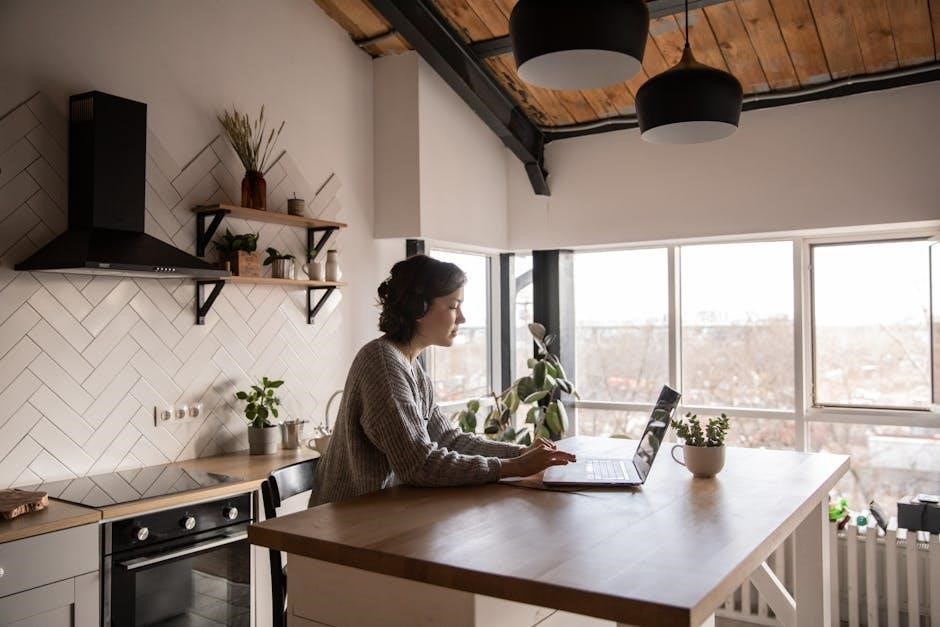Comfort-Aire Portable AC Manual: A Comprehensive Guide
This comprehensive guide provides valuable information for proper care and maintenance of your Comfort-Aire portable AC unit․ It covers installation, operation, troubleshooting, and safety precautions to ensure optimal performance and longevity․
Understanding Your Comfort-Aire Portable AC Unit
Before diving into the specifics of operating and maintaining your Comfort-Aire portable AC unit, it’s crucial to grasp its fundamental purpose and capabilities․ These units are designed to enhance living and working comfort by effectively regulating both temperature and humidity within a room․ Their inherent mobility distinguishes them, offering the flexibility to cool various spaces as needed․ This section will provide an overview of what the Comfort-Aire portable AC is, highlighting its intended use in adjusting temperature and humidity levels․ Furthermore, it will emphasize the significance of understanding the unit’s capabilities to ensure efficient and safe operation․ Familiarizing yourself with these basics will pave the way for a more informed and satisfying user experience, leading to optimal climate control in your desired environment․ Understanding the model type is important too․

Key Features and Specifications
Delve into the core features and specifications of your Comfort-Aire portable AC․ Understand its cooling prowess, power demands, and physical dimensions for optimal use and placement within your space․
Cooling Capacity and BTU Ratings
Understanding the cooling capacity and BTU (British Thermal Units) ratings of your Comfort-Aire portable AC is crucial for effective cooling․ BTU represents the amount of heat your unit can remove from a room per hour․ Higher BTU ratings are suitable for larger spaces, while lower ratings are ideal for smaller rooms․ Selecting the correct BTU rating ensures efficient cooling without overworking the unit․
Refer to your Comfort-Aire manual to identify the specific BTU rating of your model․ This information will help you determine the appropriate room size for optimal performance․ Consider factors like insulation, window size, and sun exposure when assessing your cooling needs․ An undersized unit will struggle to cool the space, while an oversized unit may cycle on and off frequently, leading to discomfort and energy waste․
The manual will also provide details on the unit’s Energy Efficiency Ratio (EER), which indicates its cooling efficiency․ A higher EER signifies better energy performance, translating to lower electricity bills․
Voltage and Power Requirements
Your Comfort-Aire portable AC unit’s voltage and power requirements are critical specifications for safe and effective operation․ The unit is designed to operate on a specific voltage, typically 115V or 120V in North America․ Supplying the incorrect voltage can damage the unit, create a fire hazard, or void the warranty․
The manual will clearly state the required voltage and power consumption (in watts or amps)․ Ensure your power outlet matches these specifications before plugging in the AC․ It’s also important to avoid using extension cords or power strips that are not rated to handle the unit’s power load․ Overloaded circuits can overheat and pose a safety risk․
Consult the manual for information on the unit’s recommended circuit breaker size․ A dedicated circuit is often recommended to prevent overloading the electrical system․ If you are unsure about your home’s electrical capacity, consult a qualified electrician for assistance․
Dimensions and Portability
Understanding the dimensions of your Comfort-Aire portable AC unit is crucial for ensuring it fits comfortably within your desired space․ The manual provides detailed measurements, including height, width, and depth, allowing you to assess its suitability for different rooms or areas․
Portability is a key feature of these AC units, and the manual outlines the design elements that contribute to ease of movement․ Look for information on the unit’s weight, as this will affect how easily it can be moved․ Many models come equipped with heavy-duty casters or built-in handles, as described in the manual, to facilitate smooth relocation from one room to another․
Consider the dimensions and weight in relation to doorways and stairways if you plan to move the unit frequently between different levels of your home․ The manual may also provide guidance on safely transporting the unit to prevent damage․

Operating Instructions
This section details how to properly operate your Comfort-Aire portable AC․ Learn about control panel functions, remote operation, adjusting fan speed, and temperature settings for optimal comfort and efficiency․
Control Panel Functions
The control panel on your Comfort-Aire portable AC provides direct access to various functions․ Familiarize yourself with the power button to turn the unit on/off․ The mode button allows you to select cooling, dehumidifying, or fan-only operation․ Use the temperature adjustment buttons to set your desired room temperature․
The fan speed button controls the airflow, typically with low, medium, and high settings․ Some models feature a timer button for scheduled operation․ Indicator lights display the current settings and any active features․ Understanding these functions ensures you can efficiently manage your Comfort-Aire portable AC unit․ Always refer to the specific model’s manual for detailed information․
Remote Control Operation
Your Comfort-Aire portable AC unit comes with a remote control for convenient operation from across the room․ The remote typically mirrors the control panel functions, including power, mode selection (cooling, dehumidifying, fan), temperature adjustment, and fan speed control․
Additional features may include a sleep mode button for energy-saving operation during the night, a timer function for setting operating schedules, and a swing button to control the direction of airflow․ Ensure the remote has fresh batteries and is pointed towards the unit’s receiver; Consult the manual for specific button functions and troubleshooting tips․ The remote enhances ease of use and allows for customized comfort settings․
Adjusting Fan Speed and Temperature
Optimizing your Comfort-Aire portable AC’s performance involves properly adjusting both fan speed and temperature settings․ Lower fan speeds are ideal for quiet operation, especially during sleep, while higher speeds maximize airflow for faster cooling․ Experiment with different fan speeds to find a balance between comfort and noise level․
Temperature adjustment allows you to set your desired room temperature․ Start with a moderate setting and gradually adjust until you achieve optimal comfort․ Consider energy efficiency when setting the temperature; a slightly higher temperature can save energy without sacrificing comfort․ The combination of fan speed and temperature settings allows you to personalize your cooling experience․

Maintenance and Troubleshooting
Proper maintenance ensures your Comfort-Aire portable AC runs efficiently and lasts longer․ This section covers cleaning, filter maintenance, troubleshooting common issues, and important safety precautions for optimal operation․
Cleaning and Filter Maintenance
Regular cleaning and filter maintenance are crucial for optimal performance of your Comfort-Aire portable AC unit․ A dirty filter reduces airflow, diminishing cooling efficiency and potentially causing the unit to overheat․ To clean the filter, first, disconnect the unit from the power outlet․ Remove the filter, usually located at the back or side of the unit, following the instructions in your manual․ Wash the filter with mild soap and water, ensuring it’s thoroughly rinsed and completely dry before reinstallation․
Dust and debris should be wiped from the exterior of the unit with a soft, damp cloth․ Never use harsh chemicals or abrasive cleaners, as they can damage the finish․ Routine cleaning prevents dust buildup, which can impact performance and trigger malfunctions, extending the life of your AC and maintaining air quality․
Troubleshooting Common Issues
Experiencing problems with your Comfort-Aire portable AC? This section addresses common issues and provides troubleshooting steps․ If the unit won’t turn on, check the power cord and outlet․ Ensure the unit is plugged in securely and the outlet is functioning․ Insufficient cooling can often be traced to a dirty air filter, which restricts airflow․ Clean or replace the filter as needed․
If the unit is cooling, but the room remains warm, check for closed vents or blocked airflow․ Ensure the exhaust hose is properly connected and not obstructed․ Water leakage could indicate a full water tank; empty it as instructed․ If issues persist after these checks, consult the complete manual or contact a qualified technician for assistance․ Addressing these simple issues will ensure your unit works efficiently․
Safety Precautions and Warnings
Prioritize safety when operating and maintaining your Comfort-Aire portable AC․ Always transport the unit in an upright position to prevent damage to the compressor․ Before cleaning, disconnect the power cord to avoid electrical shock․ Never use flammable materials to clean the unit․
Ensure the unit is placed on a stable, level surface during operation․ Do not block air vents or obstruct the exhaust hose, as this could cause overheating․ Never insert objects into the unit’s openings․ If the power cord is damaged, have it replaced by a qualified technician․ Only use the specified refrigerant if the unit requires a refill, and avoid using extension cords․ Following these precautions minimizes risks during use․

Installation Guide
Proper installation is critical for optimal performance․ This guide provides step-by-step instructions for setting up your Comfort-Aire portable AC, including venting and exhaust procedures, ensuring efficient and safe operation․
Proper Venting and Exhaust Setup
Proper venting and exhaust setup are paramount for the efficient operation of your Comfort-Aire portable air conditioner․ Incorrect venting can lead to reduced cooling capacity and potential safety hazards․ Carefully follow the instructions provided in this section to ensure that the unit is properly exhausting hot air outside of the room․ This typically involves connecting the exhaust hose to the unit and then directing the hose to a window using the included window kit․
Ensure a tight seal around the window to prevent hot air from re-entering the room․ Avoid kinking or obstructing the exhaust hose, as this can restrict airflow and cause the unit to overheat․ Regularly check the venting system for any leaks or blockages, and address them promptly․
